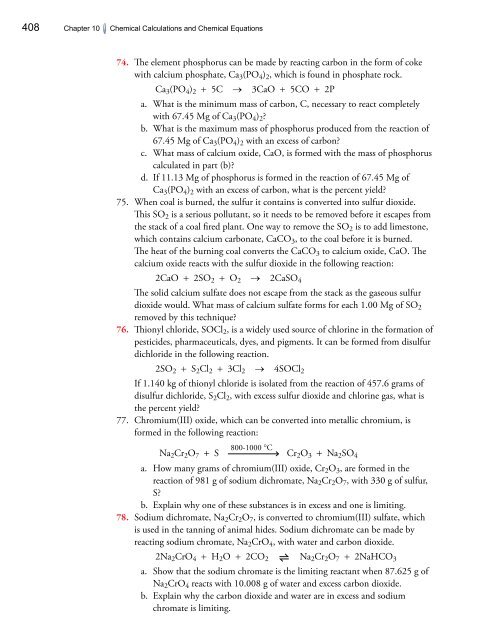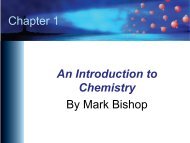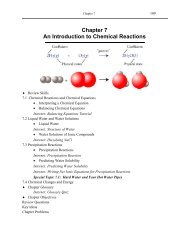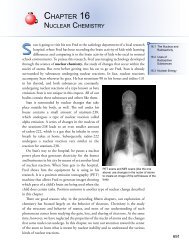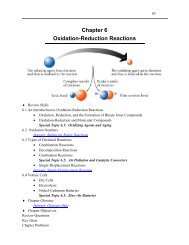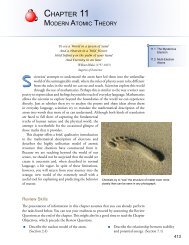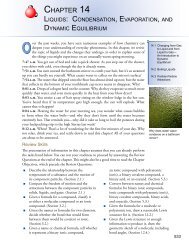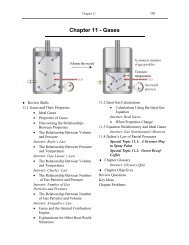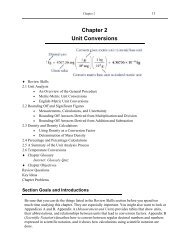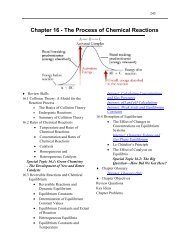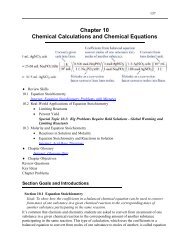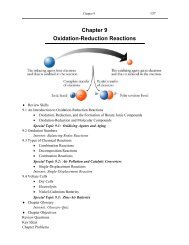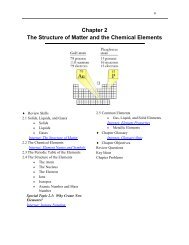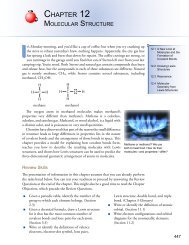Chapter 10 - An Introduction to Chemistry: Chemical Calculations ...
Chapter 10 - An Introduction to Chemistry: Chemical Calculations ...
Chapter 10 - An Introduction to Chemistry: Chemical Calculations ...
You also want an ePaper? Increase the reach of your titles
YUMPU automatically turns print PDFs into web optimized ePapers that Google loves.
408 <strong>Chapter</strong> <strong>10</strong> <strong>Chemical</strong> <strong>Calculations</strong> and <strong>Chemical</strong> Equations<br />
74. The element phosphorus can be made by reacting carbon in the form of coke<br />
with calcium phosphate, Ca 3 (PO 4 ) 2 , which is found in phosphate rock.<br />
Ca 3 (PO 4 ) 2 + 5C<br />
→ 3CaO + 5CO + 2P<br />
a. What is the minimum mass of carbon, C, necessary <strong>to</strong> react completely<br />
with 67.45 Mg of Ca 3 (PO 4 ) 2 ?<br />
b. What is the maximum mass of phosphorus produced from the reaction of<br />
67.45 Mg of Ca 3 (PO 4 ) 2 with an excess of carbon?<br />
c. What mass of calcium oxide, CaO, is formed with the mass of phosphorus<br />
calculated in part (b)?<br />
d. If 11.13 Mg of phosphorus is formed in the reaction of 67.45 Mg of<br />
Ca 3 (PO 4 ) 2 with an excess of carbon, what is the percent yield?<br />
75. When coal is burned, the sulfur it contains is converted in<strong>to</strong> sulfur dioxide.<br />
This SO 2 is a serious pollutant, so it needs <strong>to</strong> be removed before it escapes from<br />
the stack of a coal fired plant. One way <strong>to</strong> remove the SO 2 is <strong>to</strong> add limes<strong>to</strong>ne,<br />
which contains calcium carbonate, CaCO 3 , <strong>to</strong> the coal before it is burned.<br />
The heat of the burning coal converts the CaCO 3 <strong>to</strong> calcium oxide, CaO. The<br />
calcium oxide reacts with the sulfur dioxide in the following reaction:<br />
2CaO + 2SO 2 + O 2 → 2CaSO 4<br />
The solid calcium sulfate does not escape from the stack as the gaseous sulfur<br />
dioxide would. What mass of calcium sulfate forms for each 1.00 Mg of SO 2<br />
removed by this technique?<br />
76. Thionyl chloride, SOCl 2 , is a widely used source of chlorine in the formation of<br />
pesticides, pharmaceuticals, dyes, and pigments. It can be formed from disulfur<br />
dichloride in the following reaction.<br />
2SO 2 + S 2 Cl 2 + 3Cl 2 → 4SOCl 2<br />
If 1.140 kg of thionyl chloride is isolated from the reaction of 457.6 grams of<br />
disulfur dichloride, S 2 Cl 2 , with excess sulfur dioxide and chlorine gas, what is<br />
the percent yield?<br />
77. Chromium(III) oxide, which can be converted in<strong>to</strong> metallic chromium, is<br />
formed in the following reaction:<br />
800-<strong>10</strong>00 °C<br />
Na 2 Cr 2 O 7 + S Cr 2 O 3 + Na 2 SO 4<br />
a. How many grams of chromium(III) oxide, Cr 2 O 3 , are formed in the<br />
reaction of 981 g of sodium dichromate, Na 2 Cr 2 O 7 , with 330 g of sulfur,<br />
S?<br />
b. Explain why one of these substances is in excess and one is limiting.<br />
78. Sodium dichromate, Na 2 Cr 2 O 7 , is converted <strong>to</strong> chromium(III) sulfate, which<br />
is used in the tanning of animal hides. Sodium dichromate can be made by<br />
reacting sodium chromate, Na 2 CrO 4 , with water and carbon dioxide.<br />
2Na 2 CrO 4 + H 2 O + 2CO 2 Na 2 Cr 2 O 7 + 2NaHCO 3<br />
a. Show that the sodium chromate is the limiting reactant when 87.625 g of<br />
Na 2 CrO 4 reacts with <strong>10</strong>.008 g of water and excess carbon dioxide.<br />
b. Explain why the carbon dioxide and water are in excess and sodium<br />
chromate is limiting.


